kottke.org posts about Chris Ware
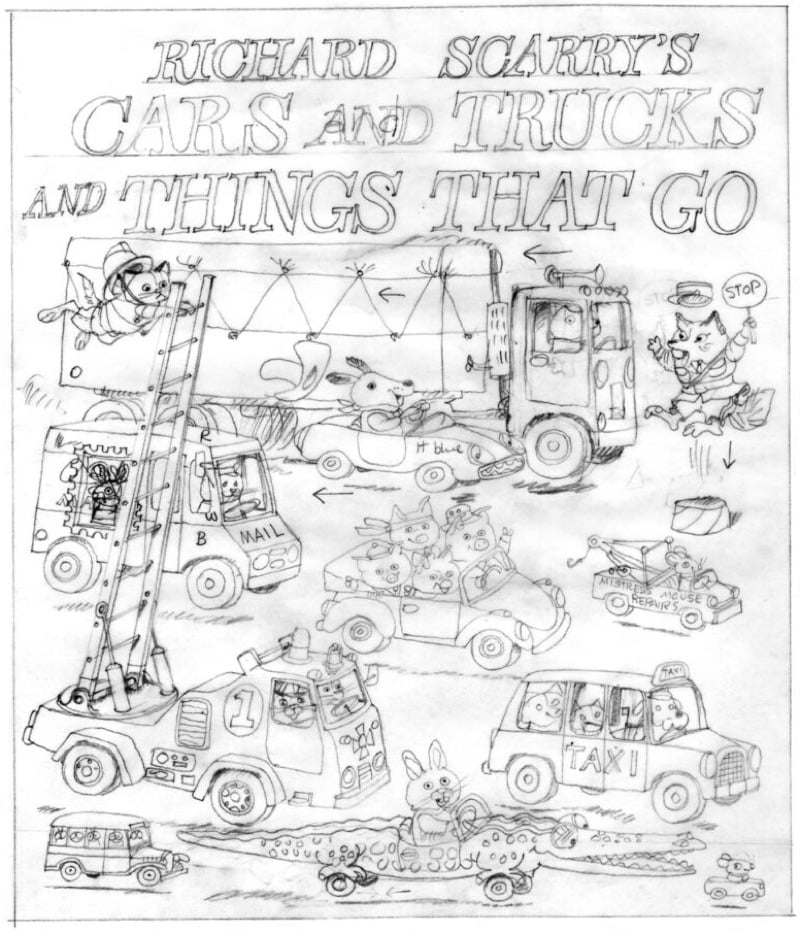
Well! In the Yale Review, Chris Ware (one of my favorite cartoonists) writes about Richard Scarry (one of my favorite children’s book authors) and Cars and Trucks and Things That Go (one of my favorite books).
This year is the 50th anniversary of Scarry’s 1974 Cars and Trucks and Things That Go, which strikes me as a commemoration worthy of ballyhoo, especially now that, as a dad myself, I’ve spent so much time ferrying my own daughter to and from school and birthday parties in various cars that-well, mostly goed. (I’ve owned five automobiles in my life, all of them cheap, one of which smoked and required the driver’s side door to be kept shut with a bungee cord hooked to the opposite armrest, stretched across both driver and passenger. What can I say? I was a young cartoonist on a cartoonist’s budget.)
Unlike those budget vehicles, however, the new deluxe Penguin Random House anniversary edition of Cars and Trucks and Things That Go is lavishly well-made, attentively reprinted with sharp black lines and warm, rich, watercolors. It includes an especially lively afterword by Scarry’s son Huck, in which he explains, using language even a kid can understand, how his dad wrote and drew the book, as well as hinting at what it was like to grow up as the son of arguably the world’s most popular and successful children’s book author.
Reader, I have never clicked “buy” faster than I did when ordering the 50th anniversary version of Cars and Trucks and Things That Go — I’m very much looking forward to peeking behind the scenes. But also, do read Ware’s whole piece…it’s an inspiring review of Scarry’s career & impact and contains all manner of little observations like these:
(Lowly was perhaps the first children’s book animal character with a real nod to the ADA and the myth of “dis”-ability, and cheerfully makes his linear form work in all sorts of inspiring and disarmingly moving ways.)
And:
But the more one looks at his work, the more one sees how the European daily grocery trip, the walk to a nearby shop or tradesman’s guild, the tiny apple car fit for a worm are not part of the blowout-all-in-for-oneself-oil-fueled-free-for-all toward which America was barreling in the late 1960s.
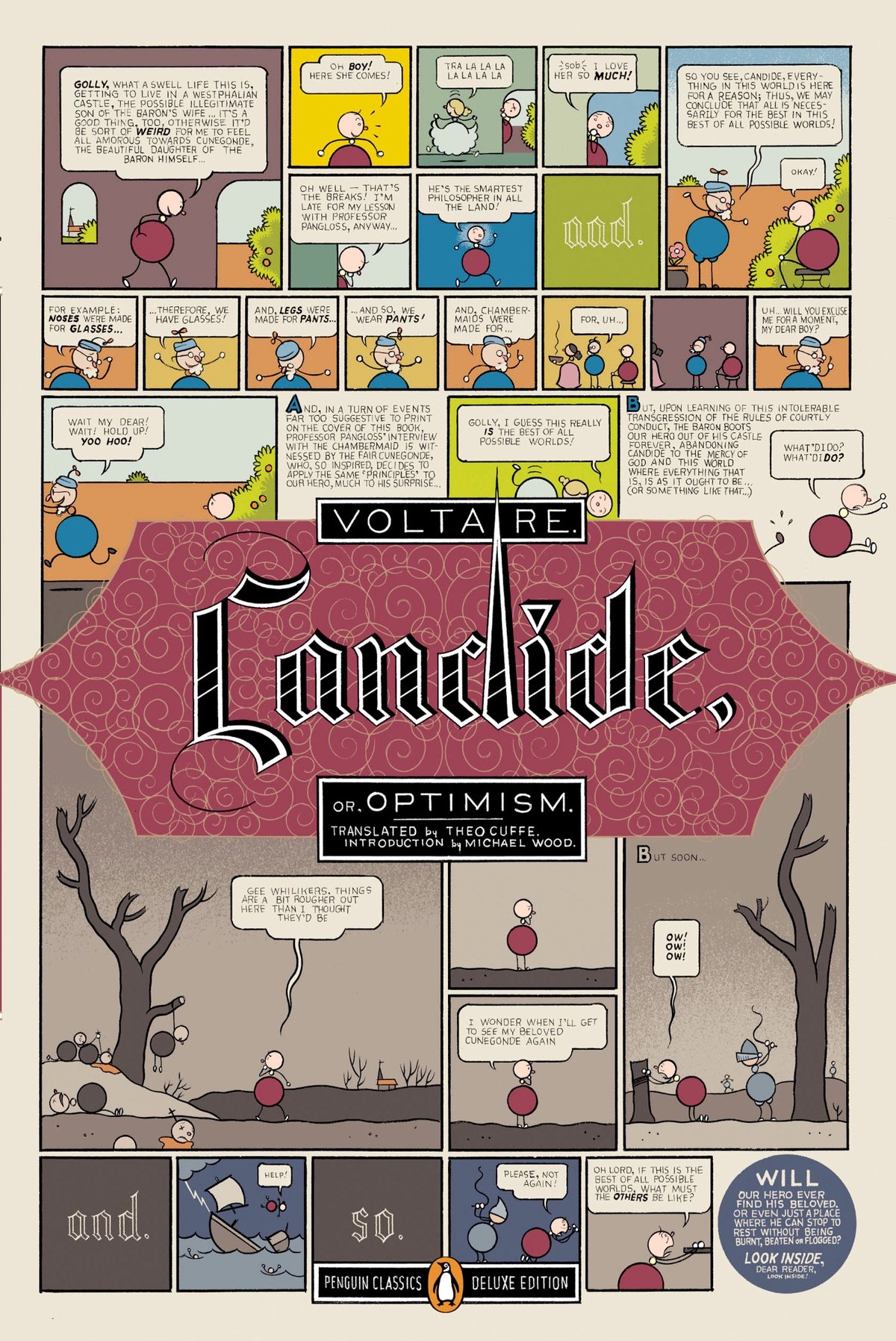
This is apparently extremely old news (like almost 20 years old), but I ran across the cover that Chris Ware did for Voltaire’s Candide in the bookstore yesterday and it still slaps.
P.S. The book covers tag is pretty good if you want to get distracted/inspired by fantastic design for 30 minutes.
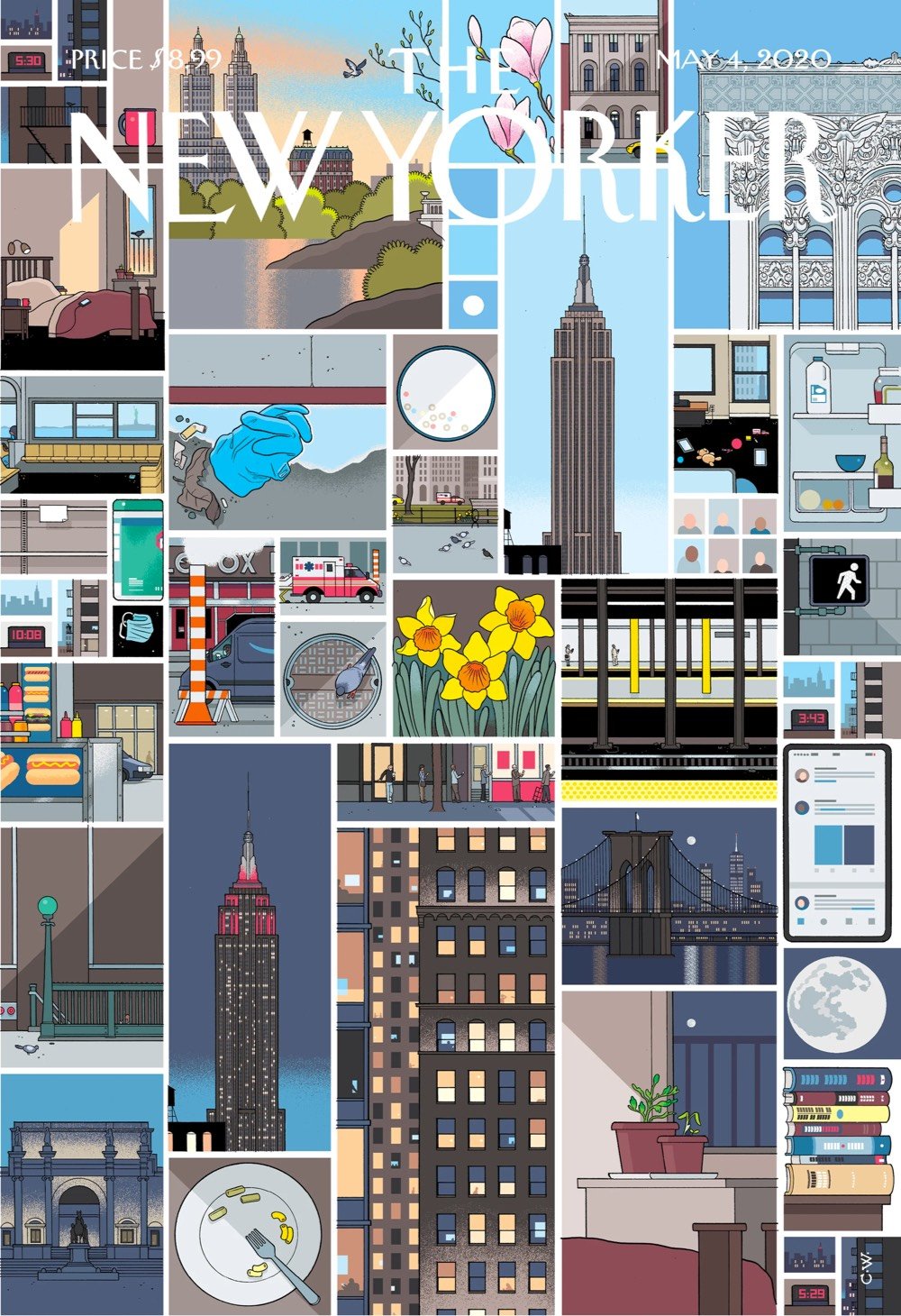
For the cover of this week’s New Yorker, Chris Ware drew several vignettes of NYC arranged in his trademark grid as a companion to this incredible piece about a single day of the Covid-19 crisis in the city. About the cover, Ware wrote:
Teeming with unpredictable people and unimaginable places and unforeseeable moments, life there is measured not in hours but in densely packed minutes that can fill up a day with a year’s worth of life. Lately, however, closed up in our homes against a worldwide terror, time everywhere has seemed to slur, to become almost Groundhog Day-ish, forced into a sort of present-perfect tense — or, as my fellow New Yorker contributor Masha Gessen more precisely put it, ‘loopy, dotted, and sometimes perpendicular to itself.’ But disaster can also have a recalibrating quality. It reminds us that the real things of life (breakfast, grass, spouse) can, in normal times, become clotted over by anxieties and nonsense. We’re at low tide, but, as my wife, a biology teacher, said to me this morning, “For a while, we get to just step back and look.” And really, when you do, it is pretty marvellous.
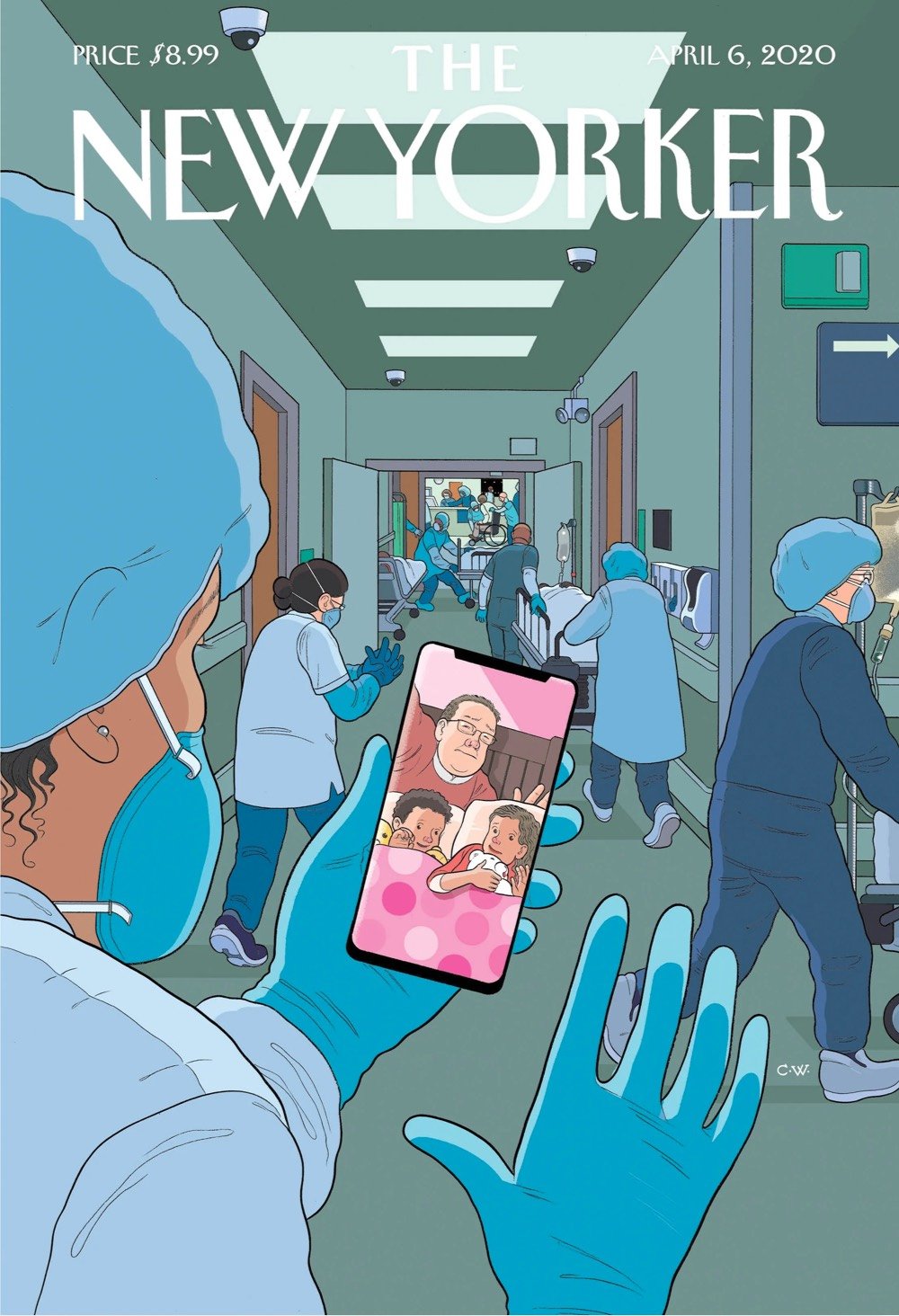
This is Chris Ware’s illustration for the cover of this week’s New Yorker, the magazine’s annual Health Issue. The pandemic had to be the topic for the cover, and Ware’s daughter suggested that the specific theme focus on the families of the healthcare workers on the front lines of the crisis.
“As a procrastination tactic, I sometimes ask my fifteen-year-old daughter what the comic strip or drawing I’m working on should be about — not only because it gets me away from my drawing table but because, like most kids of her generation, she pays attention to the world. So, while sketching the cover of this Health Issue, I asked her.
“‘Make sure it’s about how most doctors have children and families of their own,’ she said.
“Good idea. And a personal one: one of her friend’s parents are both doctors; that friend, now distilled into a rectangular puddle of light on my daughter’s nightstand, reported that her mom had temporarily stopped going to work, pending the results of a COVID-19 test.
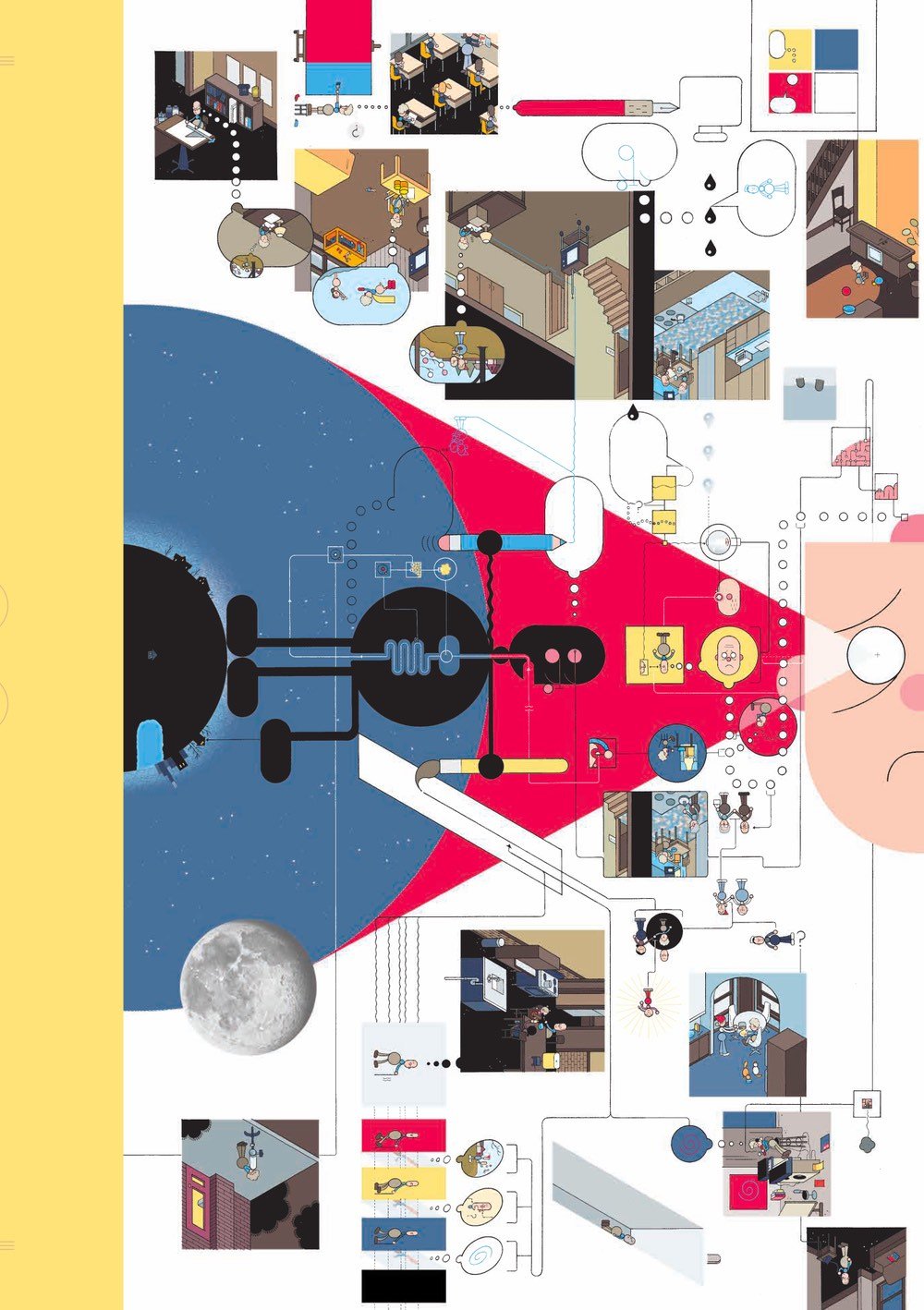
Monograph by Chris Ware is a monograph of Chris Ware’s life and work written and illustrated by Chris Ware. Got that? I liked the official description of the book from the Amazon page:
A flabbergasting experiment in publishing hubris, Monograph charts the art and literary world’s increasing tolerance for the language of the empathetic doodle directly through the work of one of its most esthetically constipated practitioners.
Kirkus liked it and Zadie Smith blurbed “there’s no writer alive whose work I love more than Chris Ware”. Instant preorder.
Chris Ware, in collaboration with John Kuramoto, Ira Glass, and Nico Muhly, made a moving cover for the latest issue of the New Yorker, both in the sense that it is actually in motion and that the story it tells is touching and makes an impression.
The New Yorker is arguably the primary venue for complex contemporary fiction around, so I often wonder why the cover shouldn’t, at least every once in a while, also give it the old college try? In the past, the editors have generously let me test the patience of the magazine’s readership with experiments in narrative elongation: multiple simultaneous covers, foldouts, and connected comic strips within the issue. This week’s cover, “Mirror,” a collaboration between The New Yorker and the radio program “This American Life,” tries something similar. Earlier in the year, I asked Ira Glass (for whose 2007-2009 Showtime television show my friend John Kuramoto, d.b.a. “Phoobis,” and I did two short cartoons) if he had any audio that might somehow be adapted, not only as a cover but also as an animation that could extend the space and especially the emotion of the usual New Yorker image.
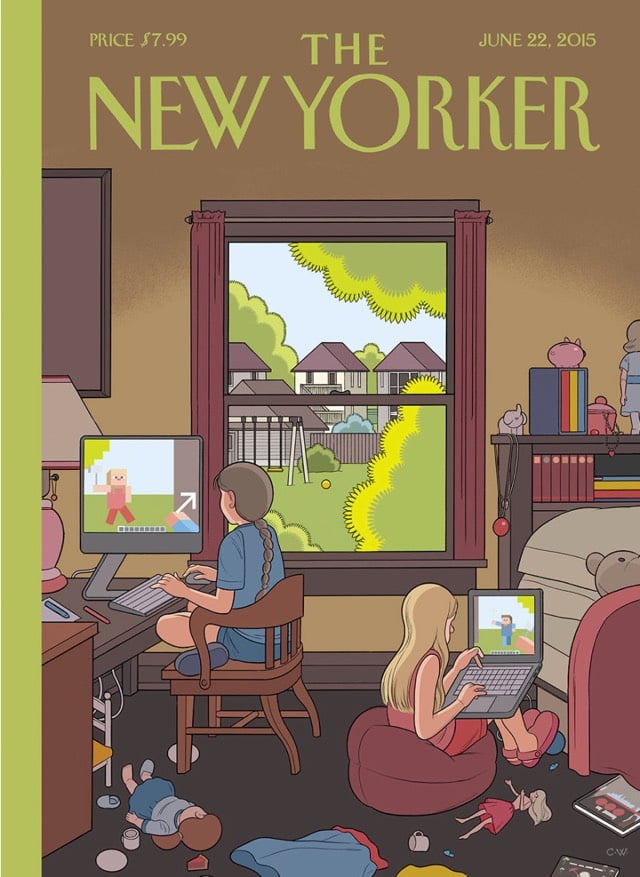
Chris Ware’s cover for this week’s issue of the New Yorker featuring a Minecraft playdate is spot on.
Clara has spent hours, days, weeks of the past two years building and making navigable block worlds fuelled from the spun-off fizz of her accreting consciousness: giant ice-cream-layered auditoriums linked to narrow fifty-foot-high hallways over glass-covered lava streams, stairs that descend to underground classrooms, frozen floating wingless airplanes, and my favorite, the tasteful redwood-and-glass “writer’s retreat.” (It has a small pool.) She made a meadow of beds for my wife-a high-school teacher who craves unconsciousness-and a roller coaster to take her there. Though Clara mostly “plays” Minecraft by herself, the game allows her friends to drop into these worlds, too, and I’ve even spent some strange virtual afternoons as a floating block-self, guided by my angelic block-hammer-wielding block-daughter, zipping around a dreamscape that feels, really, less like life and maybe more like death, but in a sweet sort of way. If architecture somehow mirrors the spaces we carve in our memories and make in our minds, then something pretty interesting is going on here.
Ollie wanted a Minecraft playdate for his birthday, basically him and three or four of his friends sitting around playing the game on various devices. We managed to talk him into some good old fashioned real-world bowling instead, but I doubt that will work next year.
I love this cutaway view of Washington DC’s Evening Star Building, drawn in 1922. The building is on the National Register as a Historic Landmark and was formerly the office of The Washington Star newspaper.

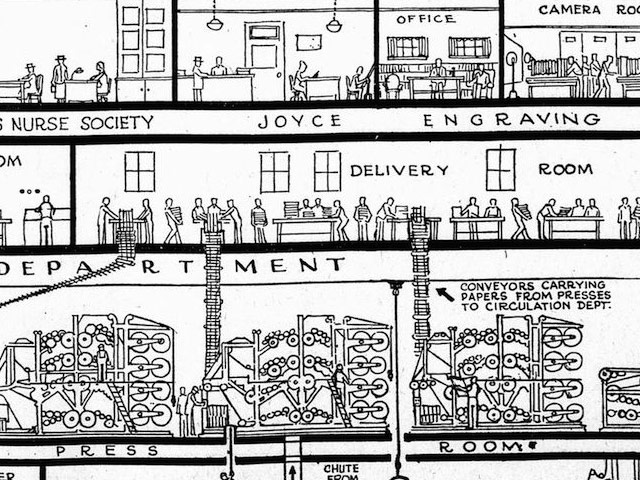
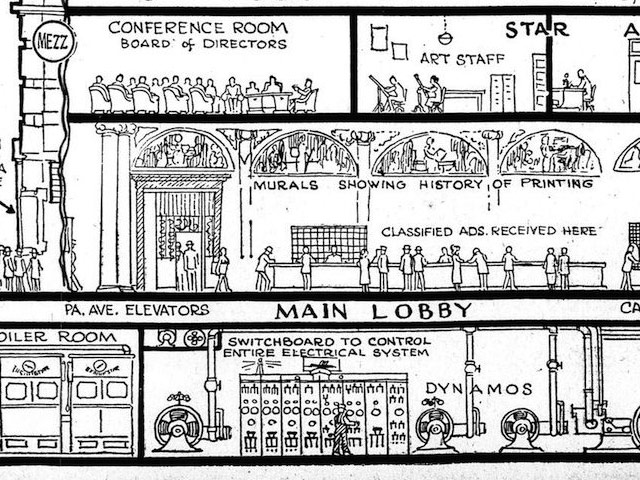
Best viewed huge. The whole thing is a fascinating view of how information flowed through a newspaper company in the 1920s. Raw materials in the form of electricity, water, telegraph messages, paper, and employees enter the building and finished newspapers leave out the back.
Found this via Craig Mod, who notes the Chris Ware-ness of the whole thing.
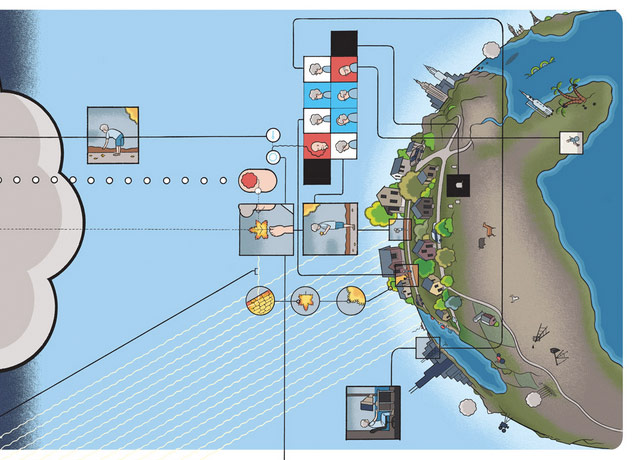
Chris Ware is publishing a new graphic novella called The Last Saturday on The Guardian web site, with a new installment appearing every Saturday. (via df)
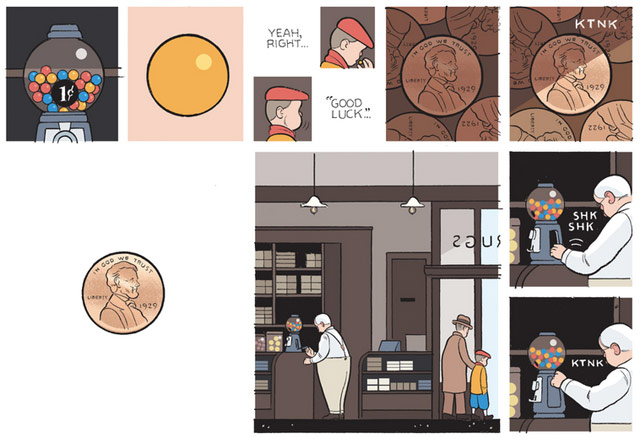
Chris Ware follows the wanderings of a penny in his latest piece for the NY Times.
Cartoonist Mike Holmes occasionally draws himself and his cat in the style of other cartoonists. He calls them Mikenesses. Here’s Holmes in the styles of Chris Ware, Aardman, and Berke Breathed:
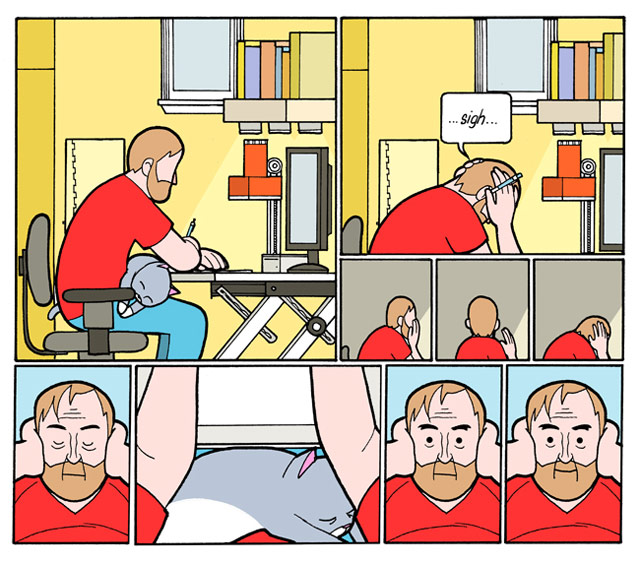

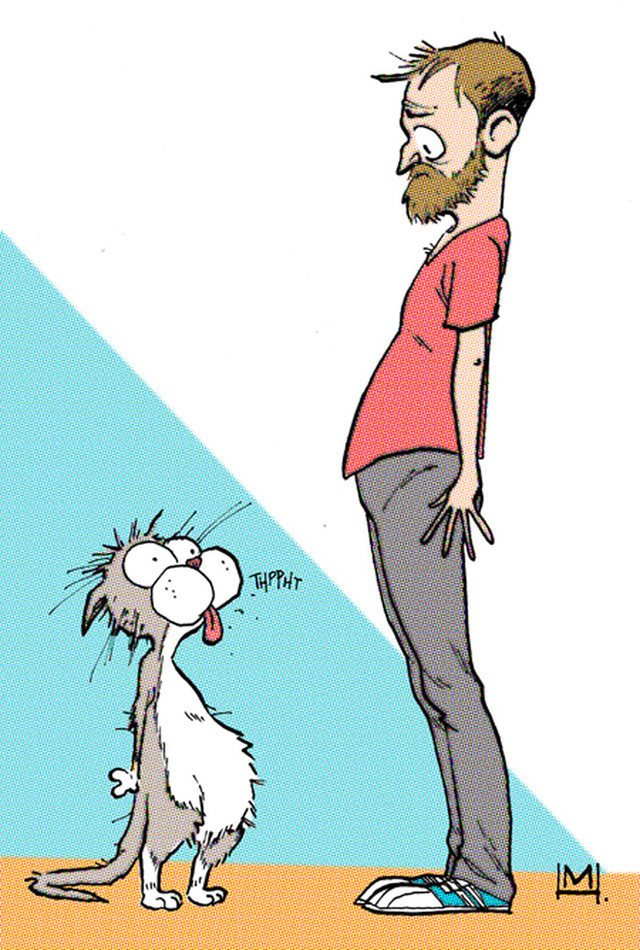
(via @H_FJ)
Chris Ware designed the Newtown-themed cover for the New Yorker last week and describes the process that went into it.
On December 14th, I helped chaperone my daughter’s second-grade-class field trip to a local production of “The Nutcracker,” where I spent most of my time not watching the ballet but marvelling at the calm efforts of the teacher to keep the yelling, excited class quieted down. Teaching was not, I concluded at one point, a profession in which I could survive for even one day. Our buses came back to the school at midafternoon, and I and the other volunteer parents left our children for another hour of wind-down time (for us, not them) before returning for the regular 3-P.M. pickup. I came home, however, not to any wind-down but to the unfolding coverage of the Newtown shooting. Shaken to the core, I returned to the school, where a grim quiet bound myself and the other parents together, the literally unspeakable news sealing our smiles while, at a lower strata, our happy, screaming children ran out of the building into our arms still frothed up by sparkling visions of the Sugar Plum Fairy.
And so it begins, the end of the year lists. Love ‘em or hate ‘em, you’ve got to, um, … I’ve got nothing here. You either love them or hate them. Anyway, the NY Times’ list of the 100 notable books of the year is predictably solid and Timesish.
BRING UP THE BODIES. By Hilary Mantel. (Macrae/Holt, $28.) Mantel’s sequel to “Wolf Hall” traces the fall of Anne Boleyn, and makes the familiar story fascinating and suspenseful again.
BUILDING STORIES. By Chris Ware. (Pantheon, $50.) A big, sturdy box containing hard-bound volumes, pamphlets and a tabloid houses Ware’s demanding, melancholy and magnificent graphic novel about the inhabitants of a Chicago building.
I absolutely demolished Bring Up the Bodies over Thanksgiving break and loved it. I haven’t had a chance to sit down with Building Stories yet, but that massive and gorgeous collection is a steal at $28 from Amazon. And as far as lists go, another early favorite is Tyler Cowen’s list of his favorite non-fiction books of the year. Cowen is a demanding reader and I always find something worth reading there. (via @DavidGrann)
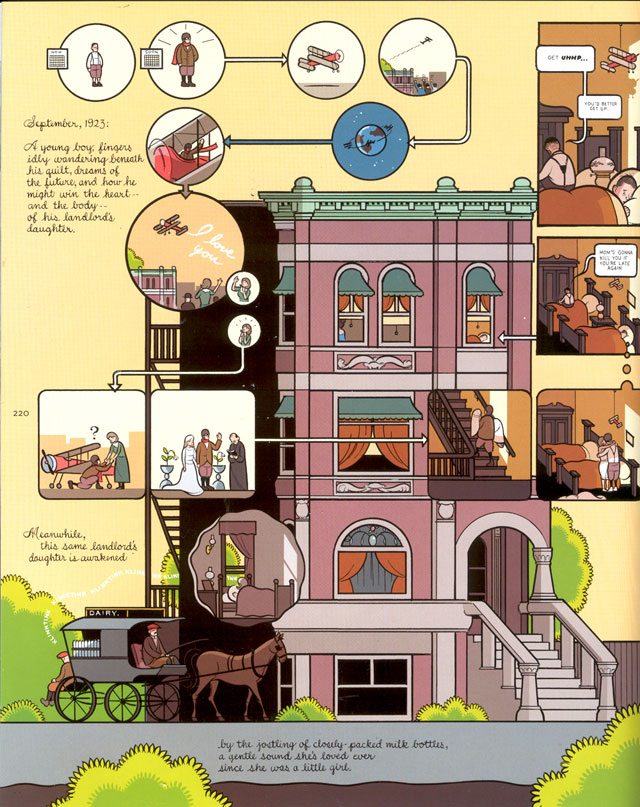
Chris Ware is coming out with a new graphic novel called Building Stories, which has appeared in bits and pieces in other places.
Building Stories imagines the inhabitants of a three-story Chicago apartment building: a 30-something woman who has yet to find someone with whom to spend the rest of her life; a couple, possibly married, who wonder if they can bear each other’s company another minute; and the building’s landlady, an elderly woman who has lived alone for decades. Taking advantage of the absolute latest advances in wood pulp technology, Building Stories is a book with no deliberate beginning nor end, the scope, ambition, artistry and emotional prevarication beyond anything yet seen from this artist or in this medium, probably for good reason.
(via @mrgan)
Update: Building Stories is actually a boxed set of small volumes. Photos and more at Comics Beat. (thx, @thebrd)
From MUBI notebook, a selection of great movies posters from 2011, including Chris Ware’s lovely one for Uncle Boonmee.
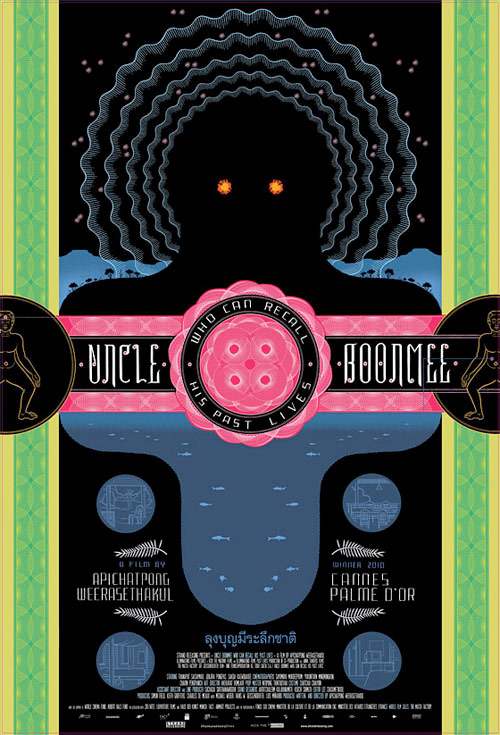
(via dooce)
Could there be a more perfect topic for kottke.org than Chris Ware’s hand-crafted olde-tyme goodness on Apple’s magical piece of technology?
In the briefest of flirtations with non-corporeality in this, his first (and likely final) iPad-only comic strip, our otherwise normally corporeal cartoonist and former McSweeney’s guest-editor Chris Ware attempts to address how, in some relationships, the act of touching seems to shift over time from that of affection to aggression. Chock full of his trademark constipated drawings and strained, overwrought text, the reader will also be pleased not to afterwards find him- or herself laden with a pamphlet or book to discard the next time he or she changes apartments, homes or relationships; like the 99 cents that instantly vanishes from one’s bank account upon purchase, all 14 speedily-swipable digital “pages” with their tucked-away animations and mildly disorienting transitions may easily be wiped from one’s computer’s memory with precisely the opposite degree of difficulty which one simply cannot forget that night of screamed obscenities at one’s (now ex-) girl- or boyfriend. (Please note, however, that all 99 cents and the rights attendant thereto remain, in perpetuity, the sole property of McSweeney’s and its satellite concerns.)
Touch Sensitive is a comic and unlike the other e-books in this store. It was crafted specifically for the McSweeney’s app and is available only in iPad format.
Get it on the app store.
This is the first part of a four-part interview with Chris Ware, in which he discusses comics, working, and family. Ware on becoming a father:
Yeah, it kind of fixed every mental problem that I had within an hour. So I highly recommend it if anybody out there is thinking of having children, you should really, I mean, it’s the only reason we’re here, and if you have any doubts in your mind about yourself or where your life is going, it’ll be answered easily and almost instantaneously. It’s a clich’e to say, but it also immediately sets you aside from yourself and you’re no longer the star of your own mind, which is really not a very good state of mind to be in. Unfortunately, in my country it is one that seems to be encouraged until about the age of 60 or something, now. I really think the main export of America is this sort of fountain of youth that we somehow manage to tap into, like with pop music — it’s not out of the question to see 50-year-old men still dressing like teenagers and I just feel like, “What happened?” It’s like we won World War II and now we can be idiots for the rest of time.
I don’t know about an hour, but yeah, similar experience here. Here’s part 2, part 3, and part 4.
Apparently Fortune magazine had never heard of Chris Ware or had not seen any of his stuff or was not aware of his worldview before getting him to do a cover for the magazine. So of course he turned in something like this (the whole thing, larger):
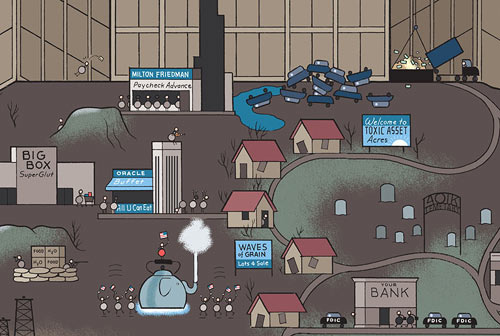
and they rejected it. (via object of my obsession)
Chris Ware has a two-page spread (+ the cover) in this week’s New Yorker.

Ware doesn’t seem like an iPhone kind of guy to me, but I guess you don’t need to be to show how disconnective these seemingly connective technologies can be.
A short video animation of Quimby the Mouse by Chris Ware. (via waxy)
Update: Vimeo has pulled the video offline. (thx, paul)
Update: The video is back online again.
The Adam Baumgold Gallery is currently showing a series of drawing by Chris Ware, Drawings for New York Periodicals. His series that ran in the NY Times and his Thanksgiving New Yorker covers are included. Feb 1 - Mar 15, 2008. (thx, evan)
Related to Jason Salavon’s work from last week is Brian Piana’s work, the layouts and colors of web sites with all of the text and graphics stripped out. For instance, Barack Obama’s Twitter page. The flowchart stuff is lovely…reminds me a bit of this page from Jimmy Corrigan. (thx, jonathan)
Bad news from McSweeney’s: their distributor filed for bankruptcy late last year and now they’re out $130,000:
As you may know, it’s been tough going for many independent publishers, McSweeney’s included, since our distributor filed for bankruptcy last December 29. We lost about $130,000 — actual earnings that were simply erased. Due to the intricacies of the settlement, the real hurt didn’t hit right away, but it’s hitting now. Like most small publishers, our business is basically a break-even proposition in the best of times, so there’s really no way to absorb a loss that big.
To try and make up the gap, they’re having a big sale and are also auctioning off some “rare items” like original art from Chris Ware, proofs from issues, signed copies of things, a painting by Dave Eggers of George W. Bush as a double amputee, and so on. In addition to Ware and Eggers, there’s stuff from David Byrne, Nick Hornsby, and Spike Jonze. I’ve long admired McSweeney’s for their editorial and business approach…it would be a shame to see them go out of business because of another company’s financial difficulties. So give them a hand by purchasing something, if you’d like.
Longish detailed interview with Chris Ware about comics, which he calls “the weird process of reading pictures, not just looking at them”.
Fascinating clip from the This American Life TV show about some grade school kids who became obsessed with using fake video cameras. Animated by Chris Ware. The thing is though, I remember fights in grade school and even in the absence of fake video cameras, students didn’t step in to stop fights. (thx, matt)
A friend of mine who works at the University of Nebraska-Lincoln emailed to let me know that they’ve posted both audio and video of a talk that Chris Ware gave at the school last week. If you’re short on time, the real meat of the video starts around 18:30 when Ware starts a slideshow that delves into his process. In addition to his series of Thanksgiving-themed New Yorker covers from last year, he also talks about some of his other work, including Rusty Brown and the strip he did for the NY Times Magazine.
“From September 27th - October 21 the Museum of American Illustration at the Society of Illustrators will host ‘30 Years of Fantagraphics,’ a retrospective art exhibition of over 100 pieces of original art published by the Seattle underground giant.” Artists in the exhibition include Chris Ware, Daniel Clowes, and Robert Crumb.
Short interview with Chris Ware upon the occasion of a show of his work at the Chicago Museum of Contemporary Art. “I’ve found that anything I do [to] carefully plan and pare down in advance feels utterly false and constructed once I actually do it, having nothing of the sort of accident and unevenness of real life that I hope to, at least, modestly edge towards.”
Older posts























Stay Connected